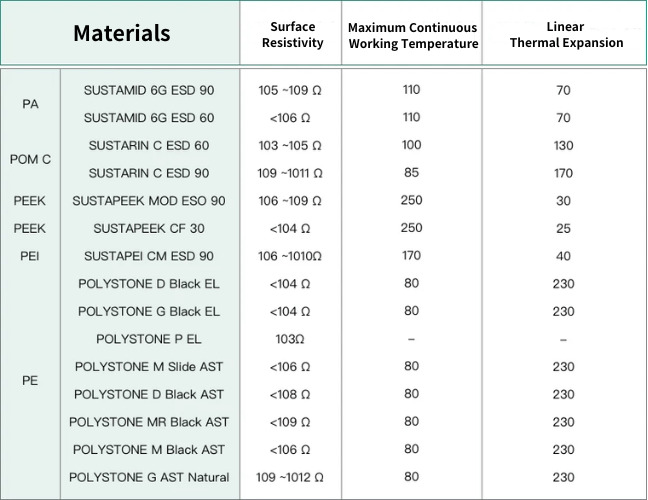1. การป้องกันการปล่อยประจุไฟฟ้าสถิต (ESD)
การปล่อยประจุไฟฟ้าสถิต (Electrostatic Discharge - ESD) คือการถ่ายโอนประจุไฟฟ้าสถิตระหว่างวัตถุสองชิ้นที่มีระดับประจุที่แตกต่างกัน โดยไฟฟ้าสถิตเป็นการไม่สมดุลของประจุไฟฟ้าที่เกิดขึ้นภายในหรือบนพื้นผิวของวัสดุ ซึ่งนำไปสู่การสร้างสนามไฟฟ้า ความไม่สมดุลนี้สามารถมีผลกระทบต่อวัตถุที่อยู่ใกล้เคียง และเมื่อความแตกต่างของประจุไฟฟ้ามีความสำคัญ จะเกิดการถ่ายโอนประจุไฟฟ้าสถิตแบบทันที ซึ่งปรากฏการณ์นี้เรียกว่า ESD
เพื่อป้องกัน ESD มักจะมีการเพิ่มวัสดุที่นำไฟฟ้าเข้าไปในสารที่ปกติแล้วไม่สามารถนำไฟฟ้าได้ ด้วยการเพิ่มองค์ประกอบที่นำไฟฟ้าเข้าไป วัสดุนั้นจะมีความสามารถในการนำไฟฟ้าดีขึ้น ทำให้ประจุไฟฟ้าสถิตที่เกินสามารถกระจายออกไปได้อย่างปลอดภัย การทำเช่นนี้ช่วยป้องกันผลกระทบที่เป็นอันตรายจาก ESD ต่อส่วนประกอบที่ละเอียดอ่อนและช่วยให้ผลิตภัณฑ์มีความน่าเชื่อถือและความปลอดภัยที่ดียิ่งขึ้นในหลายอุตสาหกรรม
2. ระวัง! การมองข้ามการปล่อยประจุไฟฟ้าสถิต (ESD) ในวัสดุอาจทำให้ผลิตภัณฑ์ของคุณเสียหายอย่างรุนแรง!
ในอุตสาหกรรมการผลิต การปล่อยประจุไฟฟ้าสถิต (ESD) สามารถทำลายส่วนประกอบและขัดขวางอุปกรณ์ ซึ่งเป็นภัยคุกคามต่อประสิทธิภาพการผลิต โดยเฉพาะอิเล็กทรอนิกส์ที่มีความละเอียดอ่อน เช่น วงจรรวม (IC) ที่มีความเสี่ยงสูง แม้กระทั่งการปล่อยประจุไฟฟ้าสถิตเพียงเล็กน้อยก็สามารถทำให้ผลิตภัณฑ์ล้มเหลวหรืออายุการใช้งานลดลง นอกจากนี้ ESD ยังเป็นอันตรายต่อความปลอดภัยของมนุษย์ด้วย
เพื่อป้องกันปัญหาดังกล่าว การควบคุมประจุไฟฟ้าสถิตอย่างเข้มงวดจึงเป็นสิ่งสำคัญ ซึ่งจะช่วยรักษาคุณภาพของผลิตภัณฑ์และความปลอดภัยของพนักงาน
3. ภาพรวมของความต้านทานการปล่อยประจุไฟฟ้าสถิต (ESD)
ESD หรือ Electrostatic Discharge คือการไม่สมดุลของประจุไฟฟ้าภายในหรือบนพื้นผิวของวัสดุ ซึ่งทำให้เกิดสนามไฟฟ้าที่สามารถมีผลกระทบต่อวัตถุอื่นๆ การปล่อยประจุไฟฟ้าสถิต (ESD) หมายถึงการถ่ายโอนประจุไฟฟ้าสถิตอย่างรวดเร็วและทันทีที่เกิดจากสนามไฟฟ้าสถิตที่สูง การนำวัสดุที่มีความสามารถในการนำไฟฟ้าเข้ามาใช้ในวัสดุที่ไม่สามารถนำไฟฟ้าได้ จะช่วยทำให้วัสดุนั้นๆ มีความสามารถในการนำไฟฟ้ามากขึ้น ซึ่งช่วยให้สามารถกระจายอิเล็กตรอนที่สะสมได้อย่างปลอดภัยและป้องกันผลกระทบจาก ESD.

4. การยืนยันวัสดุของคุณว่าเป็นไปตามข้อกำหนด ESD
Roechling แนะนำวิธีการและเครื่องมือในการทดสอบว่าวัสดุปัจจุบันของคุณเป็นไปตามข้อกำหนด ESD หรือไม่ ซึ่งหลักๆ จะแบ่งออกเป็นสองประเภท:
- Surface type: Uses two long electrode strips internally, resembling tracks, suitable for flat materials but not for rod-shaped or small-sized materials due to potential contact issues leading to inaccurately high resistance readings.

ใช้แถบอิเล็กโทรดยาวสองแถบภายใน ซึ่งคล้ายกับแทร็ก เหมาะสำหรับวัสดุที่มีพื้นผิวเรียบ แต่ไม่เหมาะสำหรับวัสดุที่มีลักษณะเป็นแท่งหรือขนาดเล็ก เนื่องจากอาจเกิดปัญหาการสัมผัสทำให้การวัดความต้านทานสูงเกินจริง
- มีอิเล็กโทรดสองตัวที่ปลายปากกาเพื่อใช้ในการสัมผัสและวัดวัสดุที่มีลักษณะเป็นแท่งหรือขนาดเล็ก โดยเครื่องมือประเภทนี้เหมาะสำหรับการทดสอบวัสดุที่ไม่สามารถใช้วิธีผิวหน้าได้ ช่วยให้การวัดความต้านทานของวัสดุมีความแม่นยำมากขึ้น

หากคุณไม่แน่ใจว่าวัสดุของคุณเป็นไปตามข้อกำหนด ESD หรือไม่ คุณสามารถส่งตัวอย่างวัสดุที่กำลังใช้งานให้กับเรา เราสามารถช่วยส่งวัสดุดังกล่าวไปยังห้องปฏิบัติการของ Roechling ที่ประเทศเยอรมนีเพื่อตรวจสอบว่าเป็นไปตามมาตรฐานวัสดุ ESD หรือไม่ หากคุณต้องการวัสดุที่มีคุณสมบัติตรงตามข้อกำหนด ESD กรุณาติดต่อเราสำหรับการปรึกษา
5. วัสดุ ESD คุณภาพสูงจาก Roechling: แก้ปัญหาสถิตของคุณ
ผู้ผลิตพลาสติกหลายรายเพิ่มสารต้านไฟฟ้าสถิตในผลิตภัณฑ์ของตนมากเกินไปเพื่อป้องกันไฟฟ้าสถิต ซึ่งอาจทำให้วัสดุเหล่านั้นกลายเป็นวัสดุที่นำไฟฟ้า และส่งผลเสียต่อคุณสมบัติทางกายภาพ เช่น ความต้านทานการสึกหรอและความแข็งแรง แตกต่างจากวัสดุอื่นๆ วัสดุจาก Roechling สามารถรักษาประสิทธิภาพในการทำงานได้ดี โดยสามารถเลือกวัสดุต้านไฟฟ้าสถิตโดยไม่ต้องเสียสละคุณสมบัติสำคัญอื่นๆ ของวัสดุ
การเลือกวัสดุ ESD ของ Roechling
